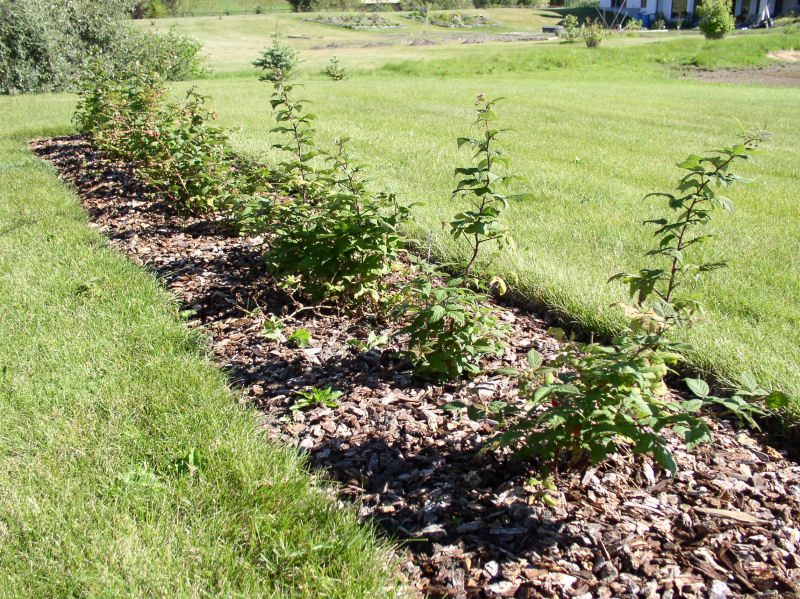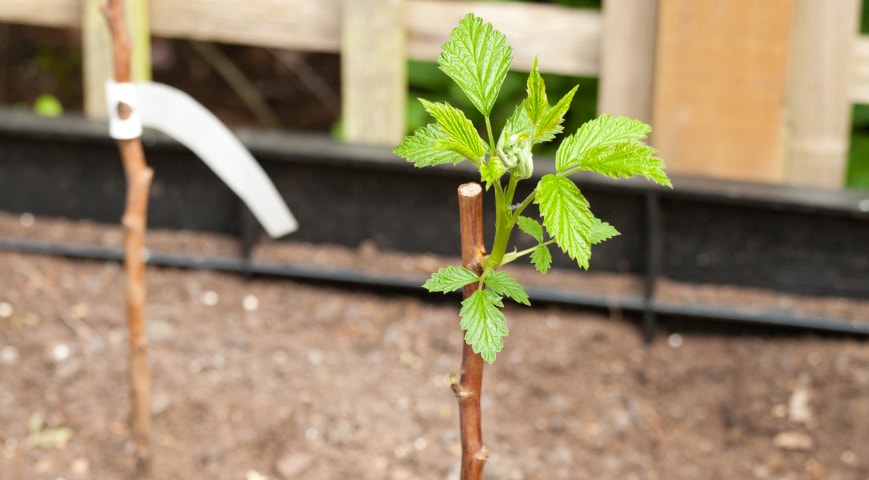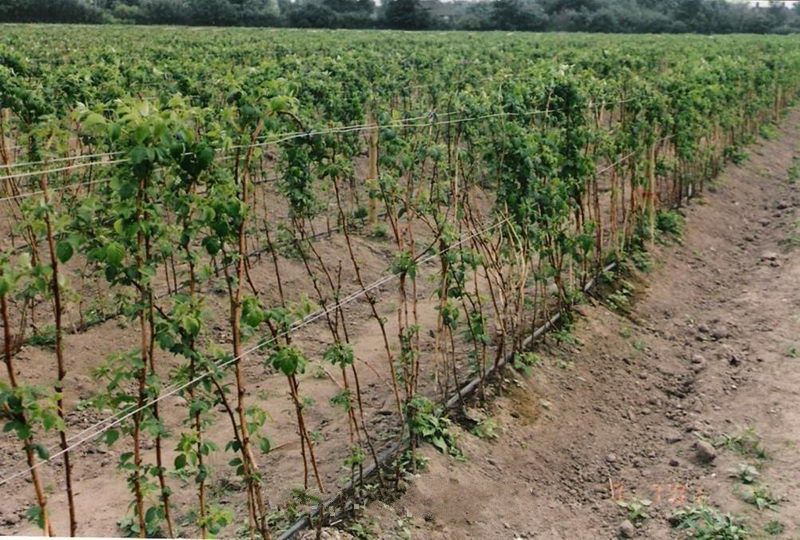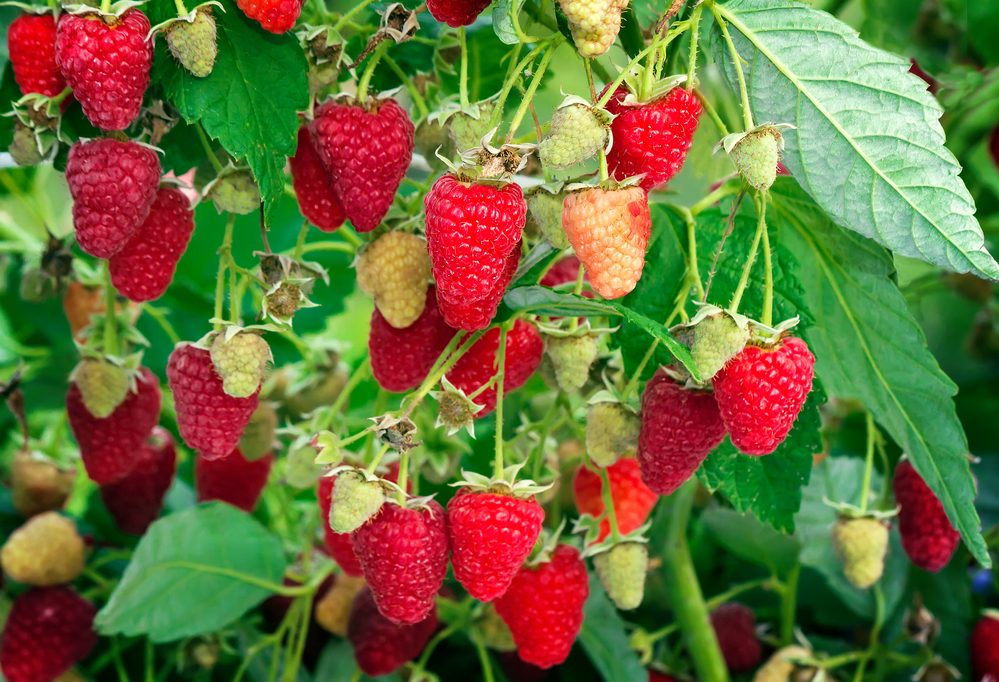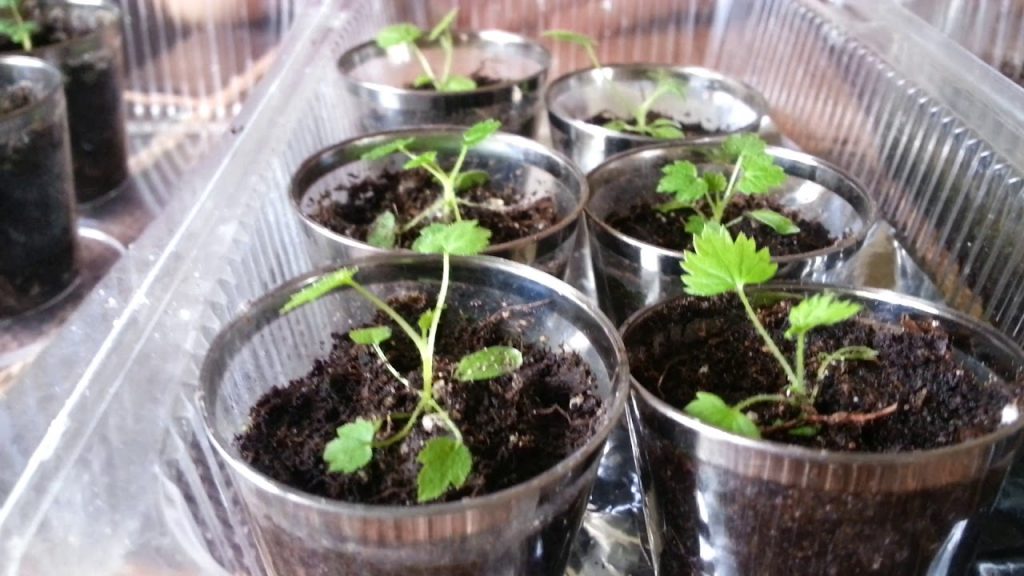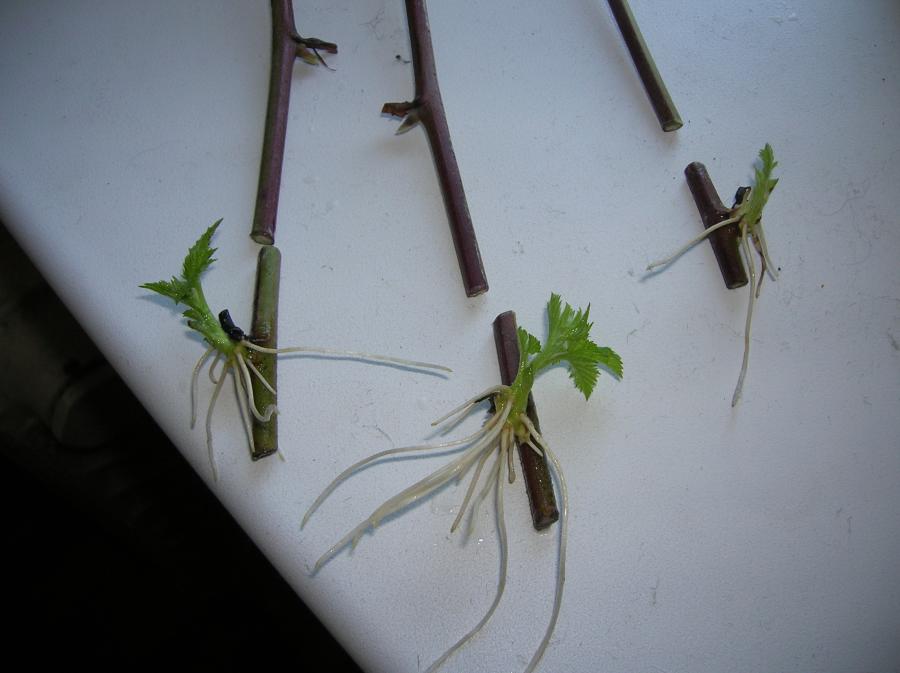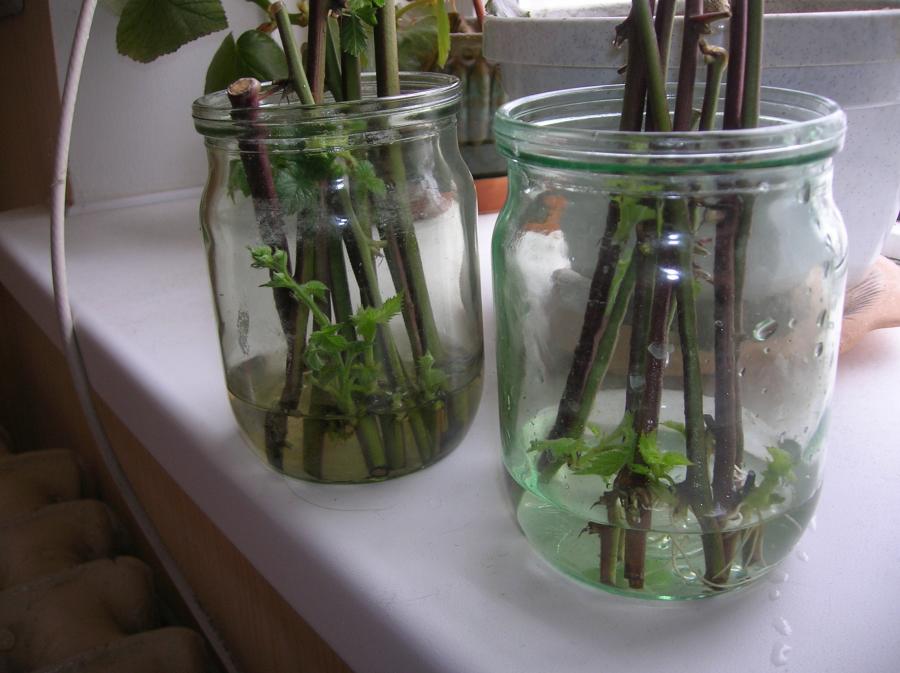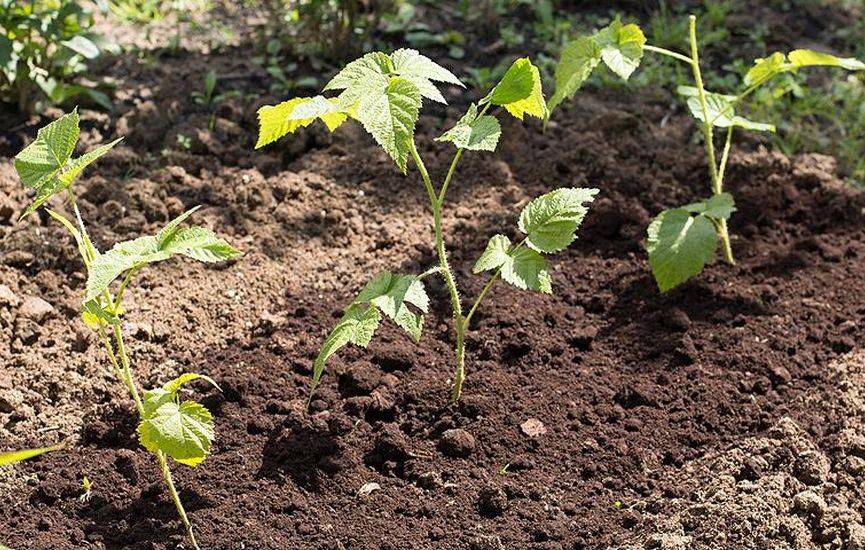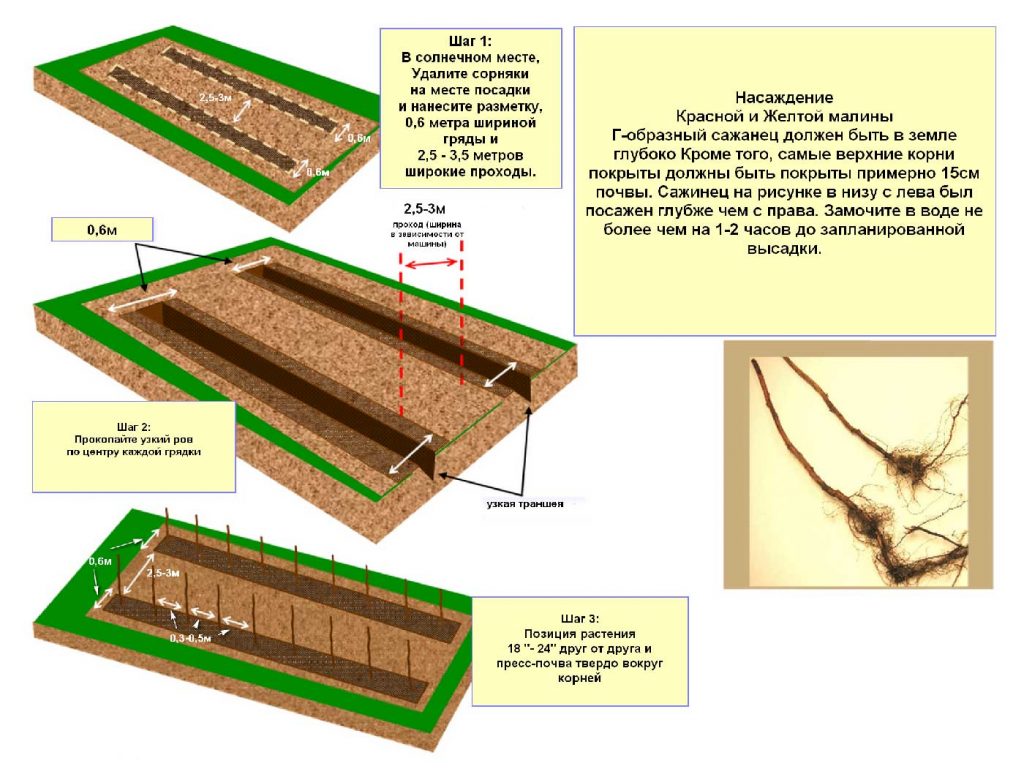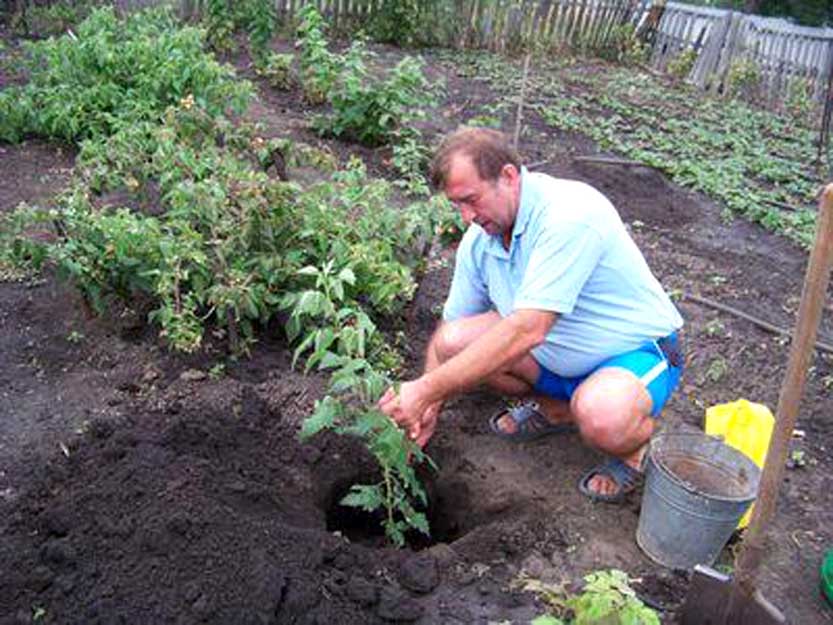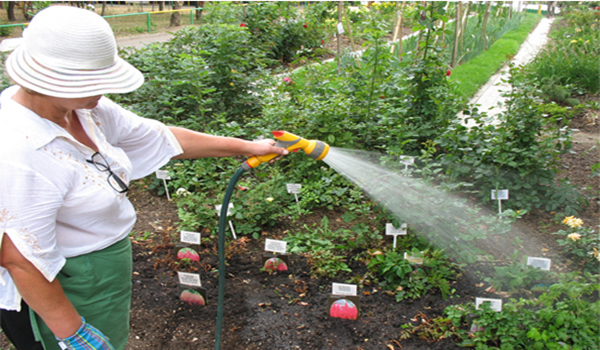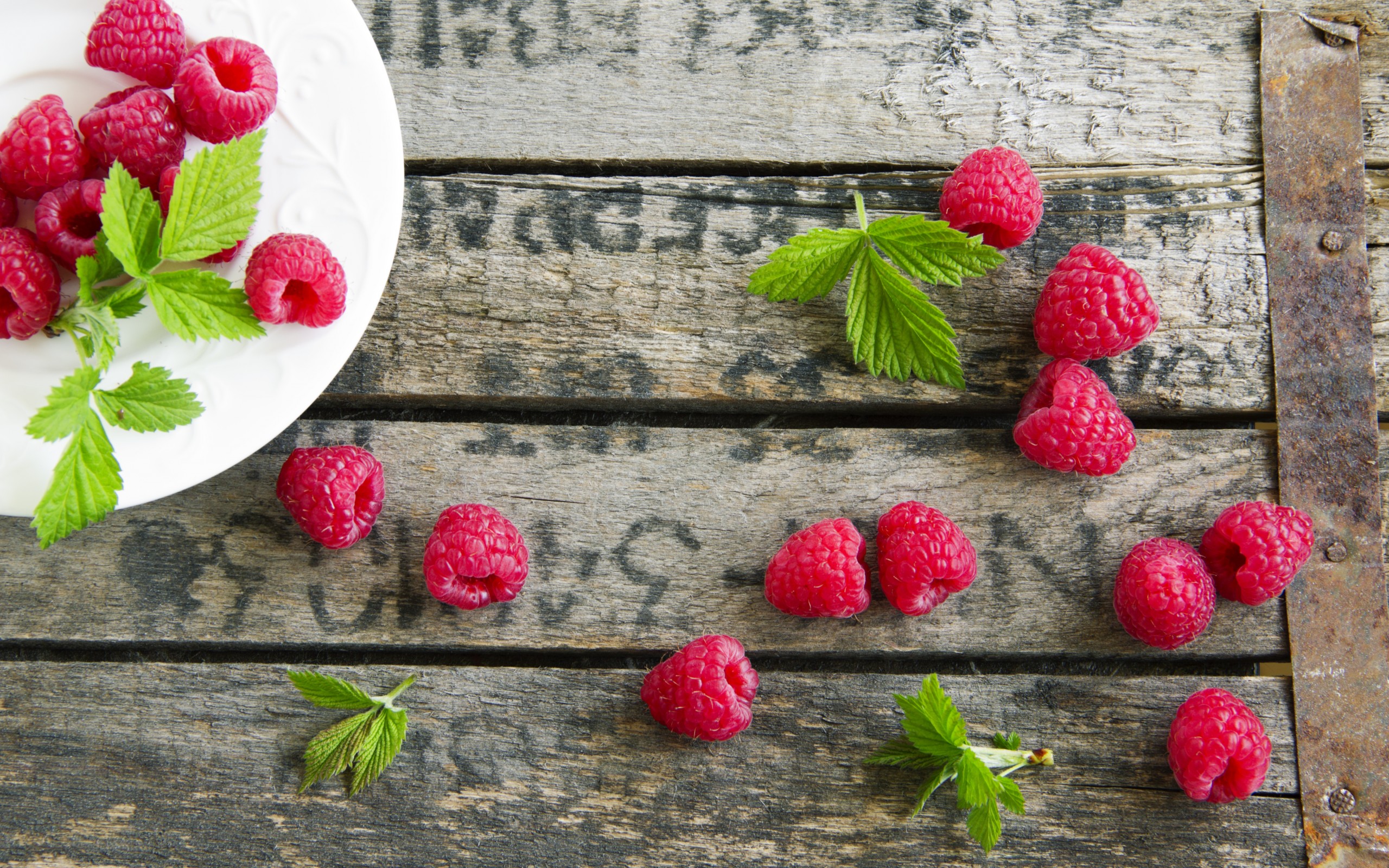The fragrant berry is grown in many garden areas. She is loved by many, useful and unpretentious. But, like any other plant, it requires proper care. Planting raspberries in the spring for beginners can be difficult due to a lack of knowledge about the growth and development of the berry bush. But this gap is easy to fill.
Content
When to start planting raspberries - in spring, autumn, summer?
Raspberries can be planted throughout the warm season. But practice has shown that the best time for this procedure is spring. There are several reasons for this.
- With the onset of warmth, sap flow begins in the plants. It strengthens the immune system and makes it easier to endure such traumatic operations as pruning, planting, vaccination.
- In spring, environmental conditions are more favorable: there is no exhausting summer heat and autumn rains.
- Most of the pests and pathogens are inactive.
The beginning of summer (first-second decade of June) and the second half of August are also considered favorable moments. During these periods of the year, young plants are not yet threatened with drying out heat and excess moisture. Another suitable period is the beginning of autumn. By this time, raspberries have already borne fruit and will tolerate the selection of planting material less painfully.
Planting methods
There are several methods for planting raspberries. There is even a whole system developed by the Kurgan gardener A.G. Sobolev. This technique has been verified by many years of practice, effective and efficient. It details all the stages: from soil preparation to the first harvest.
Landing options:
- seeds;
- seedlings;
- green cuttings;
- layering;
- lignified cuttings.
Which way to choose, their advantages and disadvantages
The choice of planting raspberries is influenced by various reasons. It may be more convenient for the gardener to get a new plant using cuttings, since he has experience of such reproduction of fruit shrubs and trees. But you should always pay attention to the effectiveness of each method.
Saplings
The easiest way is to use seedlings. This is the usual, standard procedure for every summer resident: planting a tree or shrub. There are two advantages:
- no need for growing seedlings and processing cuttings;
- the construction of a greenhouse (nursery) is not required.
There are no disadvantages of using this method.
Seeds
Seed propagation is associated with many concerns, but this method has its own plus.
Benefits:
- the opportunity to get a rare variety of raspberries.
Disadvantages:
- it will take time to prepare and germinate seeds;
- it is necessary to be able to perform picking of seedlings.
Cuttings
It is more difficult to grow raspberries using cuttings. Knowledge of how to prepare and maintain the material is required. If you have step-by-step instructions, you can handle this task.
Benefits:
- the multitude of ways to obtain cuttings.
Disadvantages:
- treatment of seed with growth stimulants is required;
- it is recommended to plant seedlings in a greenhouse, and after it gets stronger - in open ground.
An important point is the availability of tools necessary to perform the work. It is recommended to harvest cuttings using a secateurs. It allows you to get even cuts and injures the plant less than a sharp knife.
What soil should be in a raspberry tree
In order for the shrubs to grow well and bear fruit abundantly, they need a soil composition suitable for this type of plant. Favorable conditions for the growth of raspberry bushes are created by fertilizing the soil. You need to prepare it like this:
- In spring or autumn, manure is introduced into the soil at the rate 7 kg / m2... At the same time, the soil is fertilized with compost - 10 kg / m2.
- In autumn, chicken droppings are introduced - 8 kg / m2.
Rules for soil preparation in raspberry bushes:
- it is not recommended to apply nitrogen fertilizers after the harvest has been harvested;
- it is impossible to carry out work on enrichment of the soil during dry periods, as this can lead to burns of plant roots;
- shrubs should not be fed with fertilizers that contain chlorine, as this will lead to the development of chlorosis.
What fertilizers are needed for raspberries
Proper care of raspberries requires knowledge of the characteristics of the growing seasons of this plant. In this regard, it is recommended to adhere to the following feeding schedule:
- In early spring, at the beginning of the growing season, raspberries require the most phosphorus and calcium.
- In the phase of active growth - nitrogen, potassium, magnesium, iron.
- During the period of fruit setting and growth - calcium and potassium.
Optimum soil acidity is 5.5–6.5 pH.
Rules for organizing a raspberry tree in the open field
The development, growth and fruiting of plants largely depend on how well the place is chosen for them. Favorable conditions for raspberries:
- good sunlight;
- soils on which legumes, alkaloid lupine, dill, parsley, onions previously grew;
- lack of proximity to groundwater.
Note! It is not recommended to organize a new raspberry tree in place of the old one.
Landing dates depending on the method, region and lunar calendar
The timing of planting raspberries in the spring in each climatic zone is different. On average, they shift by 2-3 weeks from the northern regions to the southern ones. In order not to miss the moment, the gardener needs to focus on the following indicators:
- the optimum air temperature should be 18–26 ° С;
- air humidity level less than 40% (there should be no rain for several days before planting raspberries);
- the duration of daylight hours is not less than 12 hours.
The above planting conditions for raspberries are given for all methods of reproduction of this shrub.
For gardeners who are guided by the lunar calendar, you need to know the most favorable time for planting - from new moon to full moon.
Attention! In 2018, the optimal planting period for raspberries according to the lunar calendar is until May 5. Not all regions will be warm enough by this time. Therefore, it is recommended to pay attention to the phases and land on the waxing moon.
Breeding and planting instructions for raspberry seedlings
Seed breeding technology
The gardener is not always able to buy the desired variety of seedlings on the market or in the nursery.In this case, there is only one way out: buy seeds and grow seedlings from them. This is not a troublesome business, but it requires compliance with all requirements. The success of the event largely depends on the quality of the seed.
There are two ways to get seeds:
- purchase in specialized stores;
- independent preparation.
The sampling of seeds from a plant of your favorite variety is as follows:
- put a berry on a clean cloth, crush and spread it;
- select large, not flat seeds;
- wash them;
- dried and stored in a cool place until planting, periodically moisturizing.
The process of growing raspberry seedlings from seeds consists of several stages. In order for the seedlings to be ready for planting in spring, seeds begin to germinate from the third decade of February.
- The soil is prepared from a mixture of equal parts of sand, fertile soil and peat.
- The seeds are placed in a damp cloth for a day.
- Each seed is deepened into the ground by 0.5 cm.
- Water immediately after planting, and then every 2-3 days.
- With a frequency of 1 time in 10-12 days, fertilizing is carried out with a weak solution of urea.
- After the sprouts appear, the container is transferred to a place protected from direct sunlight.
- After each sprout has two leaves, a dive is carried out: the plants are planted in separate containers.
- When the sprouts reach a height of 10–12 cm, they are planted in a raspberry tree.
Propagation by cuttings
Reproduction of raspberries by cuttings is not the most convenient way due to its some hassle. But it gives good results. The first thing a novice gardener needs to do is learn how to harvest cuttings. Works are carried out in late May and early June.
There are three ways to accomplish this task.
Method number 1
- They choose a healthy and strong shoot of the current year and cut off its top by 15–20 cm.
- All leaves are removed from the cutting, only the top two are left.
- Cut off the upper part of the cutting (its growth point) with a sharp knife or pruner.
- At the opposite end, make 2-3 cuts along the line of the trunk. Each of them should be at least 5 cm long. This procedure will speed up the appearance of the roots.
- The cuts are treated with any growth stimulant or proceed as follows: dissolve 200 g of heteroauxin in 1 liter of water and place the cuttings in this solution for 16-18 hours. Moreover, only the lower ends of the branches are immersed in the liquid.
- They are planted in a special greenhouse-nursery.
- Watered with the solution in which they were soaked.
Advice! Before placing the cuttings in a container with a growth stimulator, they are tied into a bundle with an elastic band or ribbon.
Method number 2
- 1. Choose a shoot of the current year and cut it, departing from the root 15-20 cm.
- Divide the branch into pieces 7-10 cm long so that each has at least 2-3 buds.
- The lower cuts of the cuttings are treated with growth stimulants and planted in a greenhouse.
Attention! It is unacceptable to place cuttings in a container with water in order to germinate roots.
Method number 3
- Dig in a raspberry bush at the root to a depth of 5-7 cm.
- With a sharp knife, cut off the green shoot of this year at a distance of 5 cm below the ground. Such cuttings are called "nettles". They are distinguished by the fastest rooting.
- The lower end of the cutting is treated with wood ash.
- They are planted in the ground and watered with a growth stimulator solution.
Preparing the soil for planting cuttings
- A substrate is prepared from peat, fertile soil and sand in a 1: 1 ratio:
- The cuttings are planted in rows, maintaining a distance of 7-10 cm between them, and the rows should
be at a distance of 5-7 cm from each other.
Then fertilize the soil with Kornevin solution. In the greenhouse, the air humidity is maintained at 80%. The optimum soil temperature is + 22 ... + 25 ° С.
Note! If there is no experience in growing raspberries, to facilitate the task, the cuttings are first planted not in a greenhouse, but in peat pots. And after the appearance of the root mass, they are transferred to the ground.
Propagation by lignified cuttings
If there is a need to obtain a large number of well-rooted cuttings, use the following method:
- In the fall, after the foliage is dropped, the seedling of the selected variety is sprinkled at the root with peat.
- During the awakening period, the plants are cut from branches 7-10 cm long. Each of them should have 2-3 buds.
Further actions are similar to the previous methods: young twigs are planted in a greenhouse and watered regularly. After the cuttings take root and become full-fledged seedlings, they are transplanted into a raspberry tree.
Reproduction of raspberry seedlings
A healthy and plantable raspberry seedling must meet several requirements:
- have a well-developed root system;
- the diameter of the lower part of the root shoot must be at least 50 mm;
- the kidneys must be fully formed.
Advice! You can check the suitability of the seedling as follows: cut off one bud and see what the color of the wood is under it. If it is brown, the plant has low vitality. A healthy seedling has light and greenish wood.
Planting schemes for seedlings
There are two optimal ways to plant raspberries:
- nesting;
- tape.
But an arbitrary order is also possible. If there is no desire to breed raspberries by layering, you can plant the bushes in various containers: barrels, buckets, large pots. This will prevent root overgrowth and the formation of unwanted shoots.
Tape
When planting in rows, the distance between plants is maintained within 50–80 cm. The rows are placed at a distance of 1–1.5 m from each other. In order to prevent the growth of weeds, the inter-row space is covered with mulch. The most convenient way is to lay sheets of thin linoleum.
Saplings need support and a garter. For this, posts are installed from both ends of each row and 2–4 tiers of fishing line or thin wire are pulled between them.
Ribbon landing rules:
- The seedling trenches should be 60 cm wide and 40-50 cm deep.
- Plants are planted at a distance of 30-50 cm.
- At the bottom of the trench, at 1/3 of its height, humus is laid.
- Set the seedlings at the desired distance from each other and tie them up.
- The moat is filled with previously excavated soil.
- Slightly compact the soil.
- Watering.
Gnezdovoy
The requirements for the nesting method of planting are the same, except for the need to dig a trench. The nesting method involves the formation of a separate fossa for each plant, which are staggered.
Video: How to plant and grow raspberries without mistakes
How to plant remontant raspberries in spring
A characteristic feature of remontant varieties is the formation of a small number of shoots in the first years of the development of the shrub. This can be regarded as a "plus" and "minus" of these plants. On the plus side, it is easier to clean. Negative - in a shortage of seedlings.
Landing rules
- 2-3 weeks before the planned planting date, the area allotted for the raspberry tree is dug up and humus is added at the rate of 10 kg per 1 m2, as well as 250 g of superphosphate and potassium.
- They dig trenches or pits (50x50 cm), and form a drainage layer at the bottom. The depth of the holes should be such that the root collar of the bushes is at ground level.
- Plants are planted and the depressions are filled with soil.
- Each seedling is watered with 8-10 liters of water.
- The ground around the bushes is covered with mulch.
Seedling care
The first year after planting seedlings is the most difficult.Throughout the growing season, you need to monitor the condition of the plants and follow the recommended list of actions in time.
- The formation of the bush begins when the plants reach a height of 15 cm. Pinching is performed.
- Upon reaching 80–100 cm, the first pruning is carried out: the upper part of the shoots is cut off by 15–20 cm.
- Watering raspberries once a week is enough. But during flowering, setting and growth of fruits, more often - 2-3 times in 10 days.
- The abundance of watering should be such that the soil is moistened to a depth of 30–40 cm.
- In the raspberry plant, weeds must be removed regularly.
Video: Planting a remontant raspberry
Having mastered all the subtleties of planting raspberries, a novice gardener will be able to successfully grow bushes with different varieties of berries on his site. With proper care, the raspberry plant can produce a good harvest every year.
